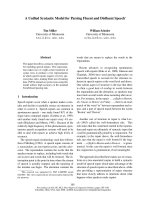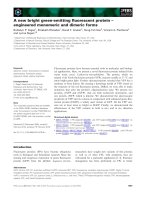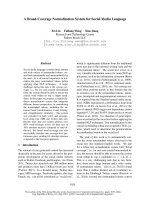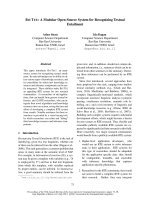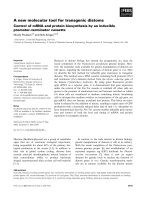Báo cáo khoa học: "A new data processing system for root growth and ramification analysis: description of methods" pot
Bạn đang xem bản rút gọn của tài liệu. Xem và tải ngay bản đầy đủ của tài liệu tại đây (216.31 KB, 5 trang )
A
new
data
processing
system
for
root
growth
and
ramifi-
cation
analysis:
description
of
methods
M.
Colin-Belgrand
H. Joannes
2
E.
Dreyer
3
L. Pages
4
1
Laboratoire
des
Sols
ef
de
la
Nutrition
des
Arbres
Forestiers,
2
Station
de
Biom6trie,
and
3
Laboratoire
de
Bioclimatologie
et
d’Ecophysiologie
Forestiere,
INRA,
Centre
de
Recherches
Forestieres,
BP
35,
54280
Seichamps,
and
4
Station
dAgronomie,
INRA,
Centre
dAvignon,
Domaine-de-Saint-Paul,
84000
Montfavet,
France
Introduction
Direct
observation
of
root
growth
in
woody
seedlings
is
possible
using
a
’minirhizo-
tron’.
Root
growth
in
this
device
occurs
almost
exclusively
at
the
interface
be-
tween
the
substrate
and
the
lower,
trans-
parent,
rhizotron
wall.
This
method
pro-
vides
a
better
picture
of
root
morphology
and
development,
but
reduces
a
three-
dimensional
root
system
to
a
plane.
Root
growth
is
generally
observed
every
2nd
day;
newly
formed
roots
are
traced
on
a
transparent
polyethylene
sheet
with
a
dif-
ferent
color
ink
for
each
date.
Previous
studies
of
root
system
charac-
teristics
required
time
consuming
manual
processing.
To
overcome
this
major
limita-
tion,
we
have
recently
developed
a
semi-
automated
data
acquisition
system
al-
lowing
a
quantitative
analysis
of
root
architecture
(Belgrand
et
al.,
1987).
This
new
data
processing
system
consists
of
3
successive
stages:
1)
semi-automated
data
acquisition;
2)
data
storage
and
growth
parameter
computation;
and
3)
the
integration
of
the
computed
parameters
into
a
developmental
model
(Pages
and
Aries,
1988).
The
technical
prerequisites
of
this
processing
system
are
described
below.
Data
acquisition
system
Basic
principles
for
analyzing
structural
features
of
root
pictures
are
the
following:
1)
a
root
is
defined
as
a
linear,
un-
branched
structure
formed
through
the
activity
of
a
single
apical
meristem;
2)
suc-
cessive
root
orders
are
defined
according
to
a
developmental
terminology
(Rose,
1983):
the
taproot
originating
from
the
hypocotyl
is
the
1 st
order
root
and
bears
2nd
order
roots
and
so
on;
3)
roots
are
treated
as
sets
of
elementary
straight
seg-
ments,
each
being
the
increment
in
root
length
between
2
successive
observa-
tions;
4)
each
root
segment
is
defined
by
the
Cartesian
coordinates
of
some
characteristic
points
(e.g.,
terminal
points
(initial
and
final)
and
branching
points
where
the
laterals
of
the
order
n
+
1
appear);
in
fact,
branching
points
are
also
the
initial
points
of
lateral
root
segments.
Fig.
1
shows
a
simplified
root
system
with
7
segments
belonging
to
5
different
roots,
a
taproot
and
4
laterals.
Root
seg-
ment
records
are
completed
with
auto-
matically
computed
information
about
the
segment
position
in
the
branching
system
hierarchy.
Coordinates
and
’structural’
information
are
stored
in
the
data
storage
structure.
Hardware
needed
for
this
processing
is
any
IBM
PC
compatible
computer
equip-
ped
with
a
color
video
screen
(EGA
or
VGA
norm)
and
a
graphics
tablet.
Soft-
ware
is
written
in
TURBOPASCAL
(ver-
sion
4.0).
Digitizing
begins
at
the
root
origin
on
the
hypocotyl
(the
oldest
observation).
The
observer
provides
some
information
about
the
experiment,
the
dates
and
associated
color
codes.
HEa
then
introduces
with
the
graphic
mouse
the
initial
point
of
the
1st
segment,
all
the
branching
points
along
this
segment
in
an
acropetal
order
and
the
final
point.
This
procedure
is
repeated
for
all
segments
on
each
date.
All
structural
information
about
root
order,
segment
identification,
etc.
are
automatically
com-
puted
without
any
direct
intervention.
Pro-
cedures
for
correction
of
errors
and
for
help
in
the
search
for
particular
points
(e.g.,
picture
enlarging,
cursor,
etc.)
are
also
provided.
Data
storage
structure
The
data
storage
structure
is
made
up
of
3
data
sets:
a
dictionary
describing
the
experiment,
the
root
segment
records
and
the
branching
point
records.
This
latter
file
contains
some
redundant
information
for
redrawing
root
pictures
more
swiftly.
Root
segment
file
Each
root
segment
contains
some
time
information
(time
of
emergence),
spatial
data
(coordinates
of
its
terminal
and
branching
points)
and
a
set
of
’structural’
indexes
(Table
I):
a
sequential
index
spe-
cifying
the
order
in
which
the
segment
was
digitized
(=
root
segment
number);
an
ori-
gin
index
whose
value
is
1
if
the
segments
is
the
1 st
one
on
its
root
(new
root)
and
2
if
it
is
the
prolongation
of
a
growing
root;
a
date
index;
a
color
code
associated
with
the
date,
for
the
video
drawing;
the
coordi-
nates
of
initial
and
final
points
(X,
Y);
a
link
to
the
previous
segment
specifying
the
sequential
index
of
the
segment
on
which
it
is
inserted;
a
running
index
which
is
the
number
of
the
root
to
which
the
segment
belongs;
the
root
order;
the
number
of
branching
points;
a
following
link
index
specifying
the
sequential
index
of
the
seg-
ment
which
follows
on
the
same
root
and,
finally,
the
rank
of
the
branching
point
giving
the
position
of
the
branch
point
on
which
the
segment
appeared.
Its
value
is
0
if it
is
the
prolongation
of
a
growing
root.
Branching
point
file
Each
branch
point
record
contains:
1)
a
sequential
index
of
the
root
segment
to
which
the
branch
point
belongs
(sequen-
tial
index
of
the
parent
root);
2)
a
real
la-
teral
index:
it
is
1
if
there
is
a
previously
digitized
lateral
segment
and
0
if
the
branch
point
does
not
yet
bear
a
lateral;
3)
a
virtual
segment
index:
this
parameter
is
used
to
help
in
the
search
for
particular
points
during
digitizing;
in
fact,
branch
points
are
not
drawn
on
the
video
monitor,
so,
in
order
to
facilitate
branch
point
identi-
fication,
virtual
segments
can
be
intro-
duced.
When
the
lateral
root
segment
is
finally
introduced,
4)
the
virtual
segment
is
automatically
deleted;
the
coordinates
of
branch
point
and
of
final
point
of
virtual
segments;
and
5)
the
rank
of
branch
point.
Final
data
structure:
resorting
root
seg-
ments
In
order
to
facilitate
the
computation
of
root
characteristics,
a
final
data
storage
structure
is
created
by
reorganizing
root
segments
through
3
successive
sortings:
1}
according
to
the
running
index,
in
other
words,
to
the
root
to
which
they
belong;
2)
according
to
ascending
root
order;
3)
according
to
the
distance
of
branching
point
from
origin
of
the
parent
root
(Dbase).
This
final
data
organization
allows
a
direct
expression
of
the
’hierar-
chic’
position
of
each
root
in
the
ramified
system
and
speeds
up
the
computing
of
growth
and
ramification
parameters.
Table
I
shows
the
final
data
structure
of
the
simplified
example
from
Fig.
1.
Growth
and
branching
pattern
analysis
Statistical
processing
of
computed
coordi-
nates
allows the
calculation
of
some
root
architectural
characteristics.
Each
root
is
specified
in
terms
of
elongation
and
ramifi-
cation.
Some
of
them
are
time-indepen-
dent,
describing
branching
patterns
(e.g.,
number
of
root,
number
of
parent
root,
root
order,
branch
angle,
Dbase,
interbran-
ch
distance
and
time
of
emergence);
the
others
evolve
with
time
(e.g.,
root
elonga-
tion
or
velocity
of
lateral
initiation,
defined
by
length
of
the
apical
non-branching
zone).
Simulation
of
ra
growing
root
system
This
procedure
uses
a
developmental
and
deterministic
model
in
which
the
move-
ment
of
each
root
tip
is
localized
in
time
and
space
(three-dimensionally)
(Pages
and
Aries,
1988).
The
parameters
intro-
duced
in
this
mode!
are
specified
for
each
root
order.
For
oak
seedling,
taproot
elon-
gation
is
quasilinear
(Elong
=
aT+
b)
and
2nd
order
root
elongation
is
exponential
(Elong
=
a
(1
e-
b
1);
the
branching
pat-
tern
is
characterized
by
5
parameters
(basal
non-branching
zone
length,
inter-
branch
distance,
apical
non-branching
zone
length,
branch
angle
and
numbers
of
generators)
and
geotropism
coefficient
(parameters
not
produced
by
the
data
acquisition
system).
Table
II gives
numer-
ical
parameters
from
a
simulation
of
root
architecture
for
a
2
mo
old
oak
seedling.
Discussion
This
new
data
;acquisition
system
allows
a
quantitative
analysis
of
root
architecture
with
all
dynamic
aspects
because
the
location
of
all
branches
and
root
tips
are
recorded
in
space
and
in
each
time
step.
This
method
will
be
very
useful
for
stu-
dying
the
changes
of
root
development
induced
by
any
stress
of
the
substrate
(e.g.,
waterlogging,
water
stress,
chemical
stress,
influence
of
fertilizers).
It
could
be
applied
to
any
ramified
structure
and
allows
a
detailed
analysis
of
growth
and
branching
patterns.
References
Belgrand
M.,
Dreyer
E.,
Joannes
H.,
Velter
C.
&
Scuiller
1.
(1987)
A
semi-automated
data
pro-
cessing
system
for
root
growth
analysis:
appli-
cation
to
a
growing
oak
seedling.
Tree
PhysioL
3, 393-404
Pages
L.
&
Aries
F.
(1988)
Mod6le
architectural
de
base
pour
1’6tude
de
la
croissance
et
du
d6veloppement
du
systeme
racinaire.
I.
Le
mod6le.
Agronomie
8,
888-897
Rose
D.A.
(1983)
The
description
of
the
growth
of
root
systems.
Plant
Soil 75,
405-415
5


